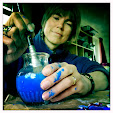
One swelteringly hot day on New Island we walked the five miles to the North End beach to see the Gentoo Penguin colony. The chicks were already large and could be left in a milling woolly creche while the parents went fishing. The adults sauntered down to the beach, others joining them en route. At the water's edge the group huddled together and gazed at the sea.

They wanted to go fishing, but they knew that a big male sea-lion was patrolling the shore. They summoned up their courage, and when one bird took the plunge, they all rushed in, anxious not to be the straggler that got caught.
Gentoos fish for squid a few miles off-shore, and return in the evening with bellies full of food for their chicks. In deep water they seem able to out-manoeuvre the sea-lion. They are stream-lined swimmers, streaking through the water, as fast as if they were flying in air. As they return to the beach they porpoise nervously along the shore, spy-hopping to catch a glimpse of the dark shadowy bulk of the waiting predator. If he can trap them in the shallows, their only escape is up the beach, and their short legs transform them from sleek speeders to tripping, tumbling waddlers.
Hoping to see this drama, I waited on the beach after our picnic . Kim and the children went off to see a Weddell Seal at the other end of the beach, and Georgina arrived to go swimming with the Commerson's Dolphins. Luckily for the Gentoos, the sea-lion didn't show up, but the penguins still raced for the shore, exploding out of the waves, anxious to put a safe distance between themselves and the sea.

The sand under the water made the beach look tropical in the bright sunlight, although Georgina assured me the water was very cold. I made more pictures of the penguins porpoising, and I'll put those up on the next posting.






